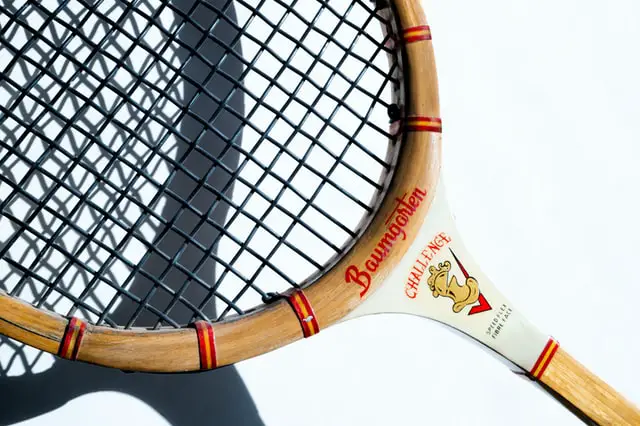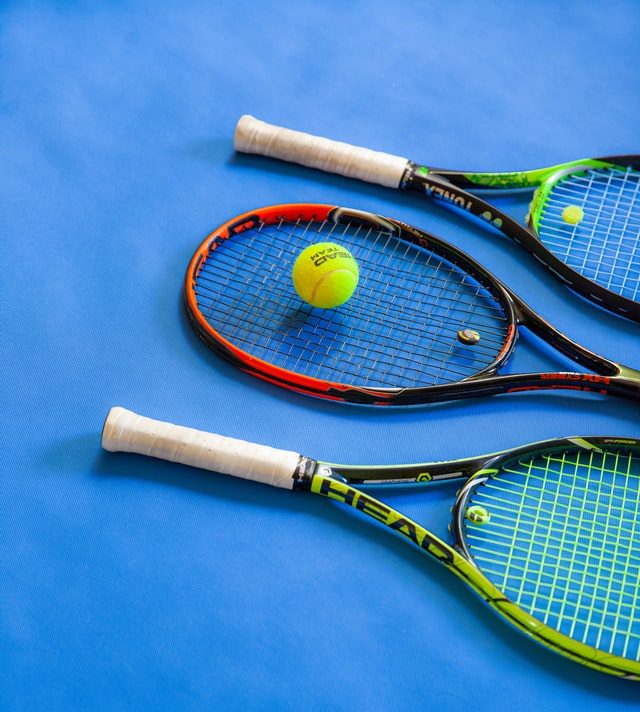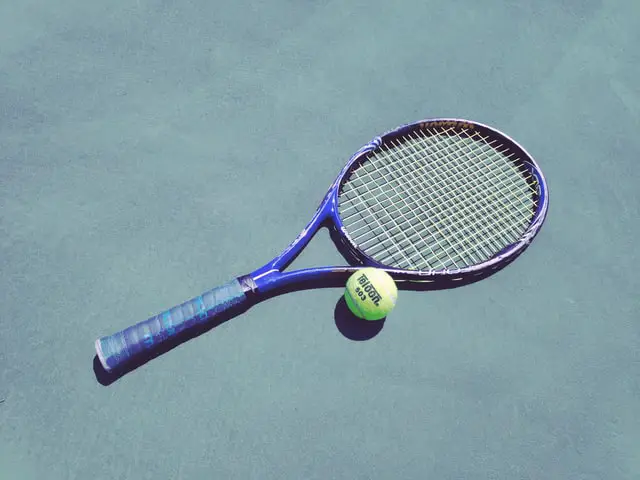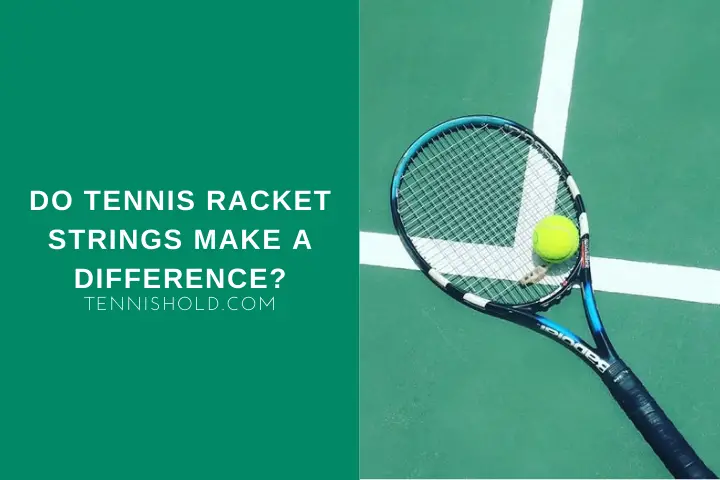You may think that if you buy an expensive racket, then the strings that come with it must be high quality. This is not always the case.
The sole purpose of factory strings is durability. It often neglects other essential factors such as topspin, control, or power. This is why most rackets aimed at advanced players are sold unstrung.
Even if you are not advanced, it might still be a good idea to consider changing your strings.
Tennis strings do make a significant difference to your playing experience. There are many different types of string, and they will all affect your game in different ways. Strings are arguably as important as the racket itself.
After reading this article, you will have a concrete understanding of the impact strings have on your game.
I will be covering:
- The effect different strings have on your game
- The best strings for topspin
- How strings impact the speed of the shot
- The gauge of string used by the top x players
Do you want to learn how to improve your game by upgrading strings? Read on and I will share with you the most important facts you need to know on the difference between strings.
What Can Strings Have Impact?

Strings have the potential to impact nearly all aspects of your play, for unless the player is not aware of his type of play, it would be pointless to find the best strings… make sure you make it very clear.
Midwest sport currently has over 130 different reels of string for sale. Not one set is identical, and every string has different qualities.
It is essential that players understand their playing style and what they want to achieve when purchasing strings. There is no such thing as the best string on the market.
The best string for you may not be the best for me, and thus, your play style and ability must be considered.
You will see some strings at the higher price end having additional specifications. One example of this is Luxilon’s rough range.
The strings in the rough range have bumps designed to bite into the ball at contact to give even more topspin.
The four most common string types today are:
- Polyester
- Natural gut
- Multifilament
- Synthetic gut
Polyester
I will start with the string I use in my mains, the polyester or rather co-poly Luxilon Big Banger Alu Power Rough. Polyester strings are used mostly by advanced and intermediate players who have a fast swing and a good level of control and spin.
Polyester gives strong players the extra control needed to swing fast without the fear of overhitting.
| Positives | Negatives |
|---|---|
| Increased control | Low power |
| Increase spin | Loses tension fast |
| More durable | Increased impact on the arm |
Natural Gut
Natural gut is one of the oldest materials used for tennis strings. It has been used since the inception of lawn tennis in the 19th century. One of the best-selling natural gut strings is the Wilson Natural Gut.
Natural gut is one of the most elastic strings available. Natural gut also holds its tension longer than any other material. It has the ability to withstand being strung at a very high tension.
| Positives | Negatives |
|---|---|
| Maintains tension for longer | Very expensive |
| Increased power | Less durable |
| Increased comfort | Vulnerable to rain |
Multifilament
Multifilament is often used as a cheaper alternative to natural gut. While it will not match the power of the natural gut, it is substantially cheaper. The most common filament used in strings today is nylon.
When I was younger a multifilament string I liked to use was the Babolat Xcel.
| Positives | Negatives |
|---|---|
| Less vibration impact | Less durable for hard hitters |
| Cheap natural gut alternative | Less control |
| Maintains tension for longer | Less spin |
Synthetic gut
Synthetic gut offers good all-around performance. This string is not usually recommended to advance players or people who break strings often. Jim Courier, who won 4 grand slams in the 1990s, was a fan of the synthetic gut, which may suit some advanced players.
Synthetic gut is the type of string I use in my crosses – Prince Synthetic Gut.
| Positives | Negatives |
|---|---|
| One of the cheapest string types | Less durable |
| All-around performance | No individual strengths |
| Suitable in hybrid string patterns | Less spin |
What Type Of Strings Are Best For Topspin?

Every year racket shops produce lists of their best strings for topspin. The one thing most have in common is that they are polyester/ co-polyester. Based on this and my personal experience, we can say that this material is best for topspin.
One reason polyester is regarded as best for topspin is due to its stiffness. This stiffness allows it to snap at the ball quick, generating topspin.
Coming in at #1 for string potential on the list is the Weiss Cannon Ultra Cable. The string is manufactured with a slippery surface which allows it to snap back at the ball with extra force.
The Cannon Ultra cable also comes with four sharp edges that bite into the ball. This functions in a similar way to Luxilon’s rough range.
Here are 3 of the top strings for topspin if you would like to check them out for yourself.
| String | Available Colors | Composition | Gauges |
|---|---|---|---|
| Weiss Cannon Ultra Cable | Yellow | Co-polyester monofilament | 17 |
| Volkl V-Square | Red | Co-polyester monofilament | 16, 17, 18, 19 |
| Solinco Hyper-G | Green | Co-polyester monofilament | 16, 16L, 17, 18 |
Can Strings Improve The Speed To The Ball?

Strings on their own will not generate pace without technique. Strings with a focus on power will help, though. Stringing at a lower tension will also assist in making the ball travel faster as it increases the trampoline effect.
Two main qualities impact power in tennis strings. The first is the softness of the string. The softer the string, the more power it generates. The second is the thickness or the gauge. The thinner the gauge, the more power the string gives.
The tradeoff for having powerful strings is that they will generate less spin. It will also not be as durable. Chances are, if you’re a hard-hitting player, you have already accepted that tradeoff.
Here are 3 of my top picks for power strings.
| String | Available Colors | Composition | Gauges |
|---|---|---|---|
| Wilson NXT Power | Natural | Multifilament (Xycro Micro fibers bonded with polyurethane) | 16, 17, 18 |
| Babolat VS Touch Natural Gut | Black, Natural | Natural Gut | 16 |
| Technifibre NRG2 | Black, Natural | Multifilament with Polyurethane | 17 |
What Gauge Strings Do Tennis Pros Use?

As with amateurs, all-pro players have different styles and preferences.
This means that not every top pro will use the same string.
I’ve created a chart with the top 3 men’s and women’s players as of 2021. Here is what strings they use.
| Player | String | Composition | Gauge |
|---|---|---|---|
| Novak Djokovic | Luxilon ALU Power | Co-polymer (nylon) + fluocarbon resin + aluminum fibers | 16L |
| Daniil Medvedev | Technifibre Razor Code | Co-polyester monofilament | 17 |
| Rafael Nadal | Babolat RPM Blast | Co-polyester monofilament | 15L |
| Ashleigh Barty | Head Hawk Touch | Co-polyester | 17 |
| Naomi Osaka | Babolat Tour VS Natural Gut | Natural gut | 16 |
| Simona Halep | Luxilon ALU Power | Co-polymer monofilament | 17 |
As you can see, most strings used by the top players are a form of co-poly.
We can assume Naomi Osaka has generous sponsors given the price of Natural gut.
Osaka actually endorses a second string, Yonex Polytour Strike. This string is polyester monofilament. So, if you use that string instead, all of them are co-poly.
Final Words
There really is a vast range of strings available today, far more than I have covered in this article.
Fortunately, strings are so cheap when compared with the cost of rackets. This gives us a great chance to experiment with different types without breaking the bank.
There are still many strings I haven’t tried, but my favorite is the Luxilon Big Banger Alu Power Rough. What’s your favorite string, and why? What string do you currently play with?

